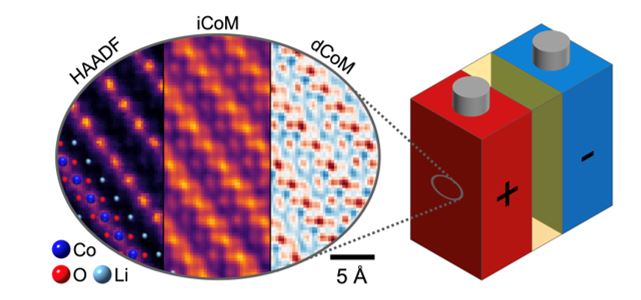Video Article Open Access
Simultaneous Imaging of Light and Heavy Elements at Atomic-Resolution in Energy Materials by CoM-STEM
Michael J. Zachman1,*, Zhenzhong Yang2, Yingge Du2, Miaofang Chi1
1Center for Nanophase Materials Sciences, Oak Ridge, TN 37831, USA
2Physical Sciences Division, Pacific Northwest National Laboratory, Richland, WA 99352, USA
Vid. Proc. Adv. Mater., Volume 3, Article ID 2210373 (2022)
DOI: 10.5185/vpoam.2022.10373
Publication Date (Web): 26 Nov 2023
Copyright © IAAM
Graphical Abstract

Abstract
Many energy materials, such as those used in battery electrodes, involve a combination of light and heavy elements, and the properties of these materials are often dictated by their structure down to the atomic scale. Analytical scanning transmission electron microscopy (STEM) has thus proven a valuable technique for understanding these materials due to its ability to reveal atomic-scale structural, compositional, and local bonding state information [1,2]. Conventional imaging modes, such as high-angle annular dark-field (HAADF), provide limited ability to image light and heavy elements simultaneously and in an easily interpretable manner. In this talk, a recent technique called center-of-mass (CoM) STEM will be discussed, which involves rapidly acquiring an image of the convergent beam electron diffraction pattern at each probe position in the two-dimensional scan over the sample [3] This technique allows atomic-scale images to be generated with contrast approximately proportional to the atomic number of the elements present, allowing light and heavy elements to be simultaneously imaged in an easily interpretable way. Results from this technique for the Li-ion battery cathode material LiCoO2 will be demonstrated, showing how the Li, O, and Co columns can all be clearly resolves and differentiated. Finally, multislice electron scattering simulations will be used to explore the robustness of the technique to variations in experimental parameters such as defocus, sample thickness, and sample tilt, as well as the sensitivity of the technique for detecting processes such as delithiation. Through these experimental and simulated results, CoM-STEM will be shown to be a robust and sensitive technique that can enable a wide range of elements to be imaged simultaneously in energy materials.
Keywords
Energy materials; batteries; STEM; CoM-STEM.
Acknowledgement
Work was supported by DOE Basic Energy Sciences early career award no. ERKCZ55. Electron microscopy research was supported by the Center for Nanophase Materials Sciences (CNMS), which is a US Department of Energy, Office of Science User Facility at Oak Ridge National Laboratory.
References
- O. L. Krivanek et al., Nature, 2010, 464, 571.
- D. A. Muller et al., Science, 2008, 319, 1073.
- M. J. Zachman et al., ACS Nano, 2022, 16, 1358.
Biography
Michael Zachman is a Staff Scientist in the Center for Nanophase Materials Sciences at Oak Ridge National Laboratory. He received his B.S. in Physics from Purdue University in 2012 and his Ph.D. in Applied Physics from Cornell University in 2018. Michael’s research interests lie in advancing electron microscopy techniques to enable understanding of the structure and properties of energy and quantum materials down to the atomic scale. His doctoral work concentrated on developing cryogenic focused ion beam (cryo-FIB) and analytical cryogenic scanning transmission electron microscopy (cryo-STEM) techniques to study processes at solid-liquid interfaces at high spatial resolution with liquids and reactive materials preserved in their native states. He applied these techniques to energy storage materials and devices to gain unique insights into processes such as dendrite and solid-electrolyte interphase layer formation in lithium metal batteries. Michael's postdoctoral research focused on developing and applying four-dimensional (4D)-STEM techniques and monochromated electron energy-loss spectroscopy (EELS) to battery and two-dimensional materials to reveal new aspects of their structures and properties at nanometer and atomic scales. As a staff scientist, Michael continues to develop, adapt, and pair techniques such as these to enhance understanding of energy storage/conversion and quantum materials.
Video Proceedings of Advanced Materials

Upcoming Congress



